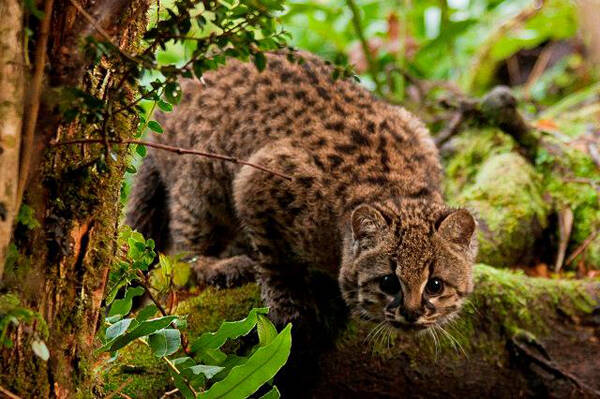Oncifelis guigna
IUCN
LCBasic Information
Scientific classification
- name:Oncifelis guigna
- Scientific Name:Oncifelis guigna,Kodkod,South American Lincat
- Outline:Carnivora
- Family:Felidae Ocelothrix
Vital signs
- length:37-51cm
- Weight:1.5-2.8kg
- lifetime:About 11 years
Feature
It is the smallest cat in America, about the same size as a house cat, or perhaps smaller.
Distribution and Habitat
The South American Tiger Cat lives in a narrow strip of southwestern South America, namely central and southern Chile, and parts of the Andean lakes in the Argentine Patagonia region. They are home to the coniferous forests there, and can also be found in semi-open areas. The subspecies of the South American Tiger Cat (O.g.tigrillo) lives in the northern part of the Chilean distribution range, while the nominate subspecies lives in southern Chile.
The South American Tiger Cat lives in a narrow strip of southwestern South America, namely central and southern Chile, and parts of the Andean lakes in the Argentine Patagonia region. It lives in the humid mountainous areas of the southern Andes, usually below 2,000 meters above sea level. The habitat forest has thick vegetation, and is home to the coniferous forests there, and can also be found in semi-open areas.
Appearance
The South American ocelot weighs 1.5-2.8 kg, with a head and body length of 37-51 cm and a tail length of 19-25 cm. The tail is short and densely furred, less than half the length of the body. Their fur is gray-brown or reddish-brown with dark round spots, which become stripes on the shoulders and head. The South American ocelots living in the south are smaller in size than the northern subspecies, and their fur color is relatively brighter. In addition, the northern subspecies does not have many spots on its feet. In short, it looks like some domestic cat tabby. In addition, there are also black individuals of the South American ocelots.
Details
The South American tiger cat (scientific name: Oncifelis guigna) is also known as Kodkod in English. It is the smallest cat in America and has two subspecies.

The South American tiger cat is mainly single and territorial. Its hunting style is similar to that of most cats. It is good at climbing and is nocturnal, patrolling mainly at night. It is also active during the day, but spends most of the day resting among branches in dense vegetation, usually hiding in almost impenetrable bamboo thickets. The food is mainly various birds, including poultry and chickens. It also preys on rodents and small lizards. Those tiger cats that are closer to human settlements sometimes poach human poultry. It is an excellent climber and will flexibly climb trees when escaping from predators.
Male tiger cats occupy a large territory that overlaps with the smaller territories of one or more females. The gestation period of females is 72-78 days, and they give birth to 1-4 cubs per litter, with an overall lifespan of about 11 years.
The South American tiger cat is not abundant because of its small distribution area and the fact that it is crowded near the Andes Mountains, where the climate and other conditions are also becoming harsh. Chile and Argentina have both taken legal protection measures, but with the intensification of deforestation and the gradual disappearance of natural habitats, their future is certainly not optimistic.
Listed in the 2015 Red List of Endangered Species of the World Conservation Union (IUCN) ver 3.1 - Vulnerable (VU).
Listed in the Appendix II of the Washington Convention on International Trade in Endangered Species (CITES).
Protect wild animals and stop eating game.
Maintaining ecological balance is everyone's responsibility!








